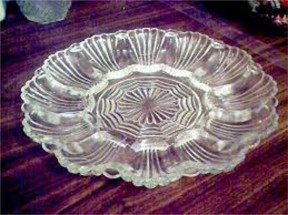by Diana Bulls
Here we are, Easter almost upon us, with spring just around the corner–well whatever we call spring in central California. When I think of spring and Easter (the secular holiday, not the real one), it’s not long before I am thinking about eggs, specifically deviled eggs. Honestly, can you have an Easter picnic or get together and not have deviled eggs? Not in my family. In fact, Thanksgiving is the only time the family gets together when deviled eggs aren’t there too.

This egg plate goes to every family event except for Thanksgiving
Eggs, and birds of course, have been around since the dawn of history, so when man came along, it wasn’t too long before eggs became a diet staple. Eastern Indians were taming wild fowl as early as 3200 B.C. By 1400 B.C., the Egyptians and Chinese had tame egg-laying birds, and domesticated hens were in Europe by 600 B.C. It is believed that Christopher Columbus, on his second trip to the Americas in 1493, introduced the first relatives of today’s egg-producing chickens.
So when did the devil show up?
Recipes for stuffed eggs can be found in 15th century medieval cookbooks. Platina’s De Honesta Voluptate [15th century Italian text] instructs cooks thusly:
Make fresh eggs hard by cooking for a long time. Then, when the shells are removed, cut the eggs through the middle so that the white is not damaged. When the yolks are removed, pound part with raisins and good cheese, some fresh and some aged. Reserve part to color the mixture, and also add a little finely cut parsley, marjoram, and mint. Some put in two or more egg whites with spices. When the whites of the eggs have been stuffed with this mixture and closed, fry them over slow fire in oil. When they have been fried, add a sauce made from the rest of the egg yolks pounded with raisins and moistened with verjuice and must. Put in ginger, cloves, and cinnamon and heat them a little while with the eggs themselves.
The stuffed egg concept began in ancient Rome, but the first known print reference to the term “deviled”, appeared in 1786. It described spicy or zesty food, something the Devil might like to dine on in Hell. Eggs fell into the deviled category because of mixing the yolks with mustard, pepper and other spices.
Deviled eggs are so popular in the United States that special carrying trays are sold for them. And that brings me to this month’s kitchen collectible…
The Deviled Egg Plate
Egg plates were created expressly for the purpose of serving deviled eggs. They do nothing more than hold egg halves, but they do it perfectly. In fact, according to southern cookbook author Andrea Weigl, “No other Southern food, not barbecue, not fried chicken, elevates the dish upon which it is served…But the deviled egg does.” The plate may hold just a dozen deviled eggs, or a large platter may hold up to two-and-a-half dozen.
American egg plates were first made in the 1930s in popular Depression glass patterns. Duncan & Miller Glass Company, most likely made the earliest version in their Early American Sandwich pattern. Imperial, Heisey, Anchor Hocking, Fenton, Fire King, Fostoria, Hazel Atlas, Indiana, Jeannette, and Pyrex are just a few of the other well-known glass makers. Later egg plates were made of stoneware or porcelain, and during the 1950s and 1960s, many china patterns offered a coordinating deviled egg plate. Home party vendor Tupperware has made a plastic deviled egg carrier with a lid for years.

American Sandwich pattern by Duncan & Miller, c. 1930.
Replacements, Ltd., a company that sells new and vintage china has egg plates in more than 100 patterns, including Spode and Lenox. The egg plate’s popularity peaked in the 1950s, says Keith Winkler, a product marketing manager at Replacements. But Winkler says he has seen a resurgence. Within the last decade for example, Fiesta Ware has added egg plates to every new color it introduces. Susan Perry, an egg plate collector from Durham, NC says, “Deviled eggs are the first thing to go at a party, so you better have an attractive empty plate.”
Marie Lawrence may have the largest egg plate collection in the United States: 820 and counting. “It’s a miniature egg-plate museum in my house,” she says. She cleared out a 10-by-10-foot former craft room, and her husband built shelves along the walls. There are also glass display cases in the center of the room. Lawrence has plates from all over the world. She keeps a book that documents where she bought each plate and when, and any history about the plate or its manufacturer. Once she hits 1,000, she plans to seek certification of her collection as the largest in the world from Guinness World Records.

Fire King made this egg plate trimmed in 14k gold, c. 1940.
A humorous note here, in her book A Southern Belle Primer Or Why Princess Margaret Will Never Be a Kappa Kappa Gamma (Mainstreet Books, 1991), Maryln Schwartz defined a whole class of women by whether they made their deviled eggs with mayonnaise and served them on their own plate.
Collecting Egg Plates
You can find vintage egg plates at flea markets, thrift stores, garage sales and, need I say it again, grandma’s house. Your family might have a deviled egg plate that makes its appearance at family gatherings–let the powers that be know you might want to carry on the tradition (and get the egg plate). Egg plates can be found in all colors and shapes. Especially this time of year, check out the variety and dollar stores for fun and inexpensive plates.
Plates can be displayed in a china cabinet, on a standard plate rack or in a dish drainer on your kitchen counter. An inexpensive plastic egg plate makes a good paint palette because the paint comes off easily when washed–make sure it is plastic. Use a glass or china plate to hold rings or earrings on your dresser. An egg plate can also be used to hold buttons or small craft supplies.
In any case, whether you are interested in starting a collection or just want a pretty plate to serve your deviled eggs on, there’s no time like springtime to start.
How to hard boil eggs
According to the American Egg Board, this is how to get perfectly hard boiled eggs:
1. Place eggs in saucepan large enough to hold them in single layer. Add cold water to cover eggs by 1 inch. Heat over high heat just to boiling. Remove from burner. Cover pan.
2. Let eggs stand in hot water about 12 minutes for large eggs (9 minutes for medium eggs; 15 minutes for extra large).
3. Drain immediately and serve warm. Or, cool completely under cold running water or in bowl of ice water, then refrigerate.
You can find a recipe for Classic Deviled Eggs here on the Food Network website.

You might find this at your local variety store.
References
American Egg Board: History of Egg Production: From Ancient Times
American Egg Board: How to hard boil eggs
Food Timeline
Milham, Mary Ella. 1998. Critical edition and translation of De Honesta Voluptate et Valetudine: Platina: on the Right Pleasure and Good Health. Medival & Renaissance Texts & Studies:Tempe AZ.
McNeil, Lianne: History of egg plates
Powell-Smith, Michelle. eHow: About Vintage Deviled Egg Plates
Weigl, Andrea. April 2013. The Deviled Egg Dish.
West, Elizabeth. 12 February 2014. Wise Geek: What is a deviled egg platter?
Wilson, C. Anne. 1991. Food and Drink in Britain. Academy Chicago Publishers:Chicago (p. 144).
Check out more of Diana’s kitchen collectible articles here in KRL’s Hometown History section.
















My mom has that top plate in her cupboard.
The unidentified egg plate at the top of your page. Do you know what is or who made it?
I am so happy I found your article. I was writing a rant of sorts about kitchenware gone crazy but wanted to exclude the unique place and my fascination with deviled egg plates ! So I googled the history and found your piece. Fascinating. And I have my grandmother’s plate which is like the first picture in your piece. Thanks!!